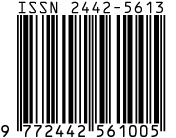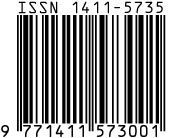Study of Dehydration of Ricinoleic of Castor Oil By P2O5
Abstract
The aim of this research is to find out the best temperature, time and amount of dehydrator on dehyration of ricinoleic of castor oil by P2O5. Dehydration as means to obtain linoleic and CLA (conjugated linoleic acid) as glyseride forms. Dehydration was carried out using various temperature, time and amount of dehydrator. The reaction medium was maintained under vacuum through by silica gel to reduced water, gentle bubling with nitrogen thorough by Mg to prevent oxidation, and used Zn powder as an antipolymerization agent. Dehydration was followed by GC which the best result was caused the lowest ricinoleic and the highets linoleic and CLA. Identification was done by FTIR, UV and GC- MS and it was compared with the standard. The best dehydration was obtain for 200oC, 3% (w/w) P2O5, and 4 h with a convertion factor (yield) of 97,94%. The composition of best result was: 1.02% (9c – 12c) linoleic, 41.97% (9c/t – 12t/c) linoleic, 19.50% (9c/t-12t/c) CLA, 4.89% (9t – 12t)linoleic,19.79%(9t–11t)CLA and0.94%ricinoleic.TheratioofCLA:linoleicofdehydrated was 0.82 : 1 or 76.18 % compared to the standard CLA with the proportions of 1.45:1.











